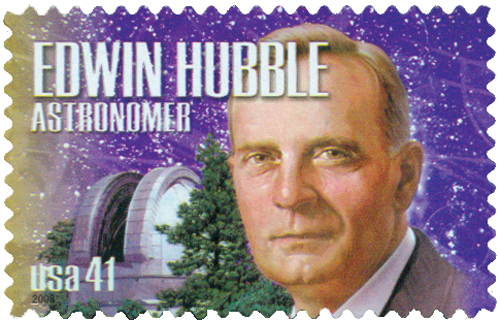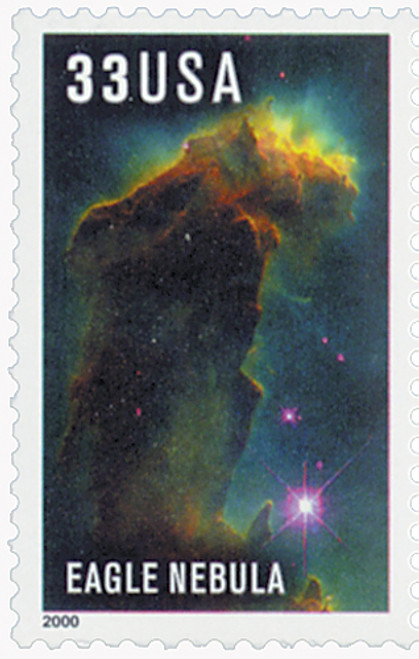
# 3384-88 - 2000 33c Edwin Powell Hubble
2000 33¢ Edwin Powell Hubble
City: Greenbelt, MD
Quantity: 105,350,000
Printed By: American Packaging Corp. for Sennett Security Products
Printing Method: Photogravure
Perforations: 11
Color: Multicolored
Birth Of Astronomer Edwin Hubble
Edwin Powell Hubble was born in Marshfield, Missouri and later moved to Illinois. As a child, he was a gifted athlete with an interest in science, though his grades didn’t always reflect his brilliance.

Hubble concentrated on mathematics and astronomy at the University of Chicago before studying at The Queen’s College in Oxford, England, as a Rhodes Scholar. He nearly gave up a career in science when he changed his academic focus to law, at his father’s request.
After graduating, Hubble came back to the United States and took a job teaching Spanish, physics, and mathematics. Following his father’s death, Hubble decided to pursue his real passion – astronomy. He then worked at the Yerkes Observatory in Wisconsin as a graduate student and earned his Ph.D. As the US entered World War II, Hubble joined the Army and reached the rank of lieutenant colonel, though he never saw combat.
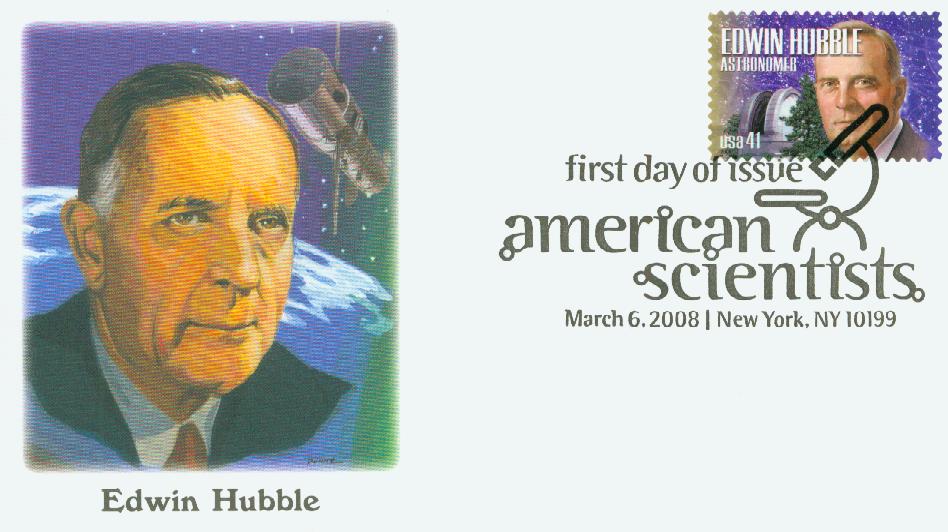
After spending a year in Cambridge studying astronomy, Hubble was offered a position at the Mount Wilson Observatory near Los Angeles, California. It was here that he made one of his greatest discoveries while using a 100-inch reflecting telescope to study nebulae. Originally considered part of our own Milky Way galaxy, Hubble discovered these nebulae were actually galaxies beyond our own. He created a classification of these galaxies, known as the Hubble tuning fork diagram, which sorted them by shape and distance.
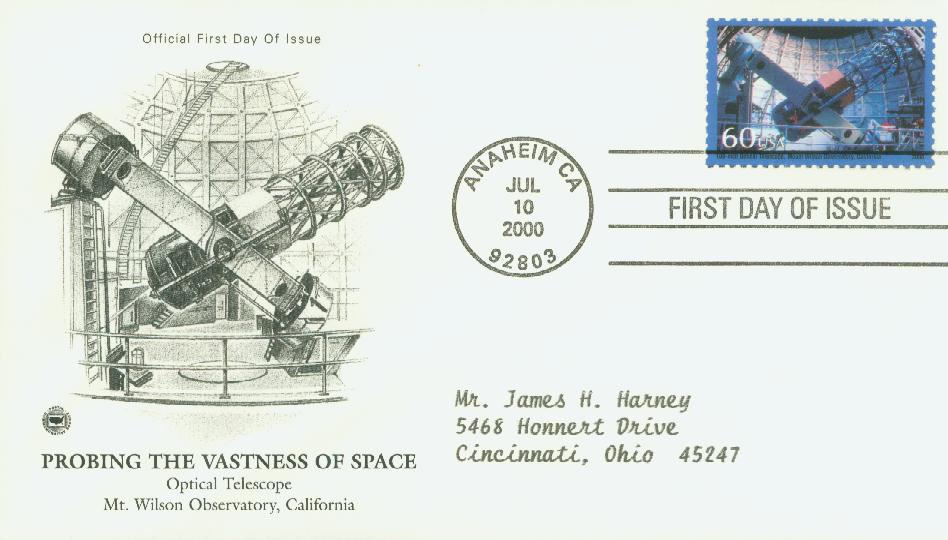
Hubble’s studies also revealed that galaxies move away from each other, creating an expanding universe, an observation known as Hubble’s Law. This led to the Hubble Constant, which is a simple mathematical expression that estimates the size and age of the universe. It indicates the rate at which the universe is expanding. His work provided the evidence supporting the Big Bang theory of how the universe was formed.
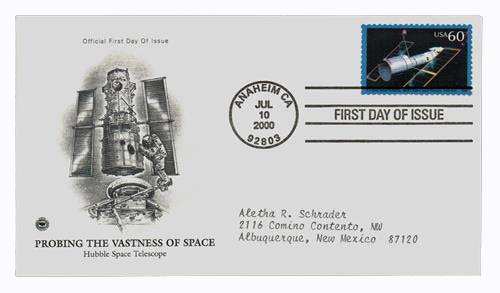
Hubble spent much of his later career trying to get astronomy considered an area of physics for Nobel Prize consideration. Hubble died on September 28, 1953, shortly before the Nobel Committee decided to include astronomy in their considerations for the physics prize. Unfortunately, the prize couldn’t be awarded posthumously.
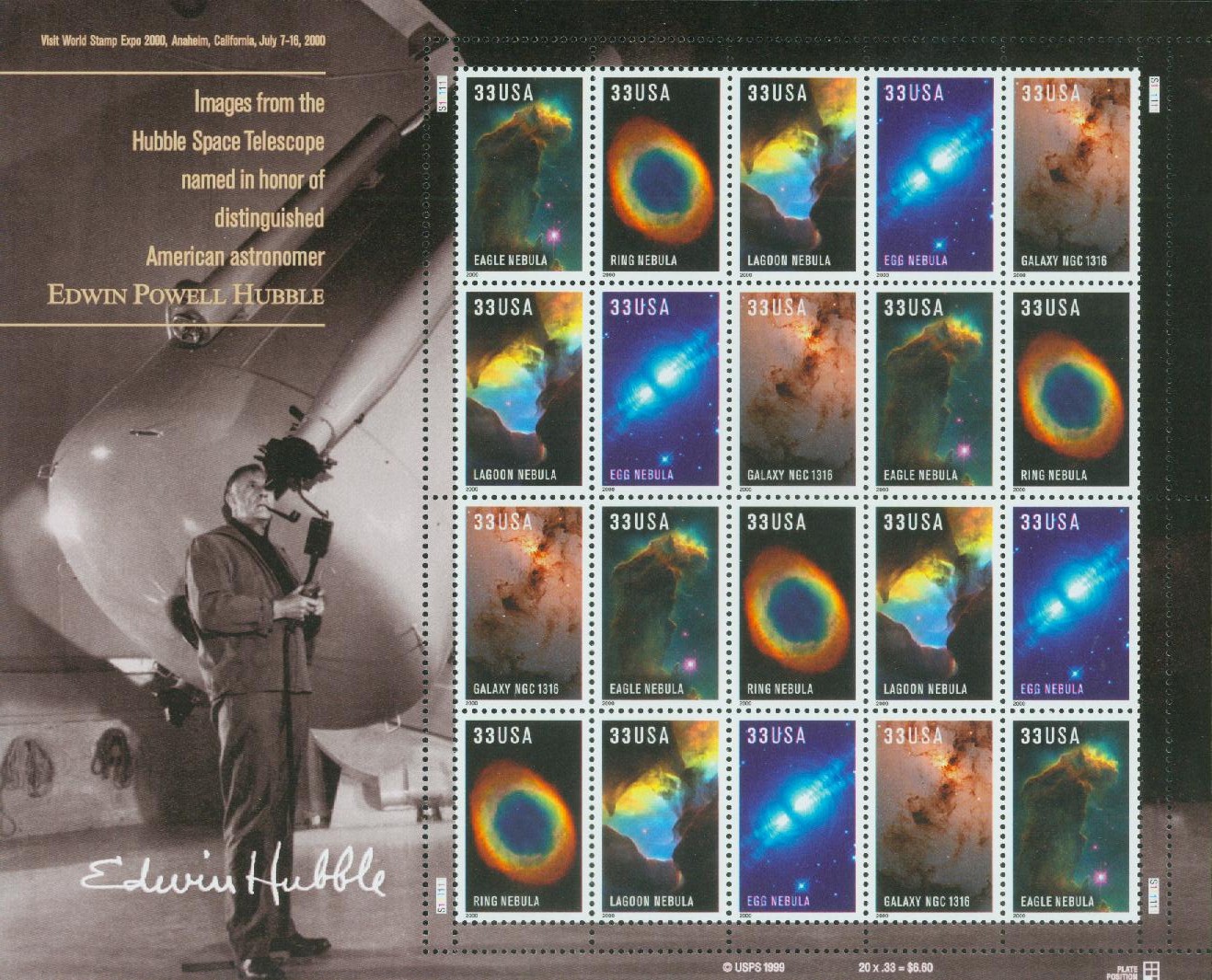
However, Hubble’s name lives on in perhaps an even more enduring way – the Hubble Telescope. Launched in 1990, the Hubble telescope gives incredibly clear images of the objects in deep space. It was named to honor the man who discovered the breadth of our cosmos. The Hubble orbits 380 miles above the Earth, beyond the atmosphere which would blur the images. It can detect objects 50 times fainter than those observed from Earth-bound telescopes.
Click here to view images captured by the Hubble Telescope.
2000 33¢ Edwin Powell Hubble
City: Greenbelt, MD
Quantity: 105,350,000
Printed By: American Packaging Corp. for Sennett Security Products
Printing Method: Photogravure
Perforations: 11
Color: Multicolored
Birth Of Astronomer Edwin Hubble
Edwin Powell Hubble was born in Marshfield, Missouri and later moved to Illinois. As a child, he was a gifted athlete with an interest in science, though his grades didn’t always reflect his brilliance.

Hubble concentrated on mathematics and astronomy at the University of Chicago before studying at The Queen’s College in Oxford, England, as a Rhodes Scholar. He nearly gave up a career in science when he changed his academic focus to law, at his father’s request.
After graduating, Hubble came back to the United States and took a job teaching Spanish, physics, and mathematics. Following his father’s death, Hubble decided to pursue his real passion – astronomy. He then worked at the Yerkes Observatory in Wisconsin as a graduate student and earned his Ph.D. As the US entered World War II, Hubble joined the Army and reached the rank of lieutenant colonel, though he never saw combat.

After spending a year in Cambridge studying astronomy, Hubble was offered a position at the Mount Wilson Observatory near Los Angeles, California. It was here that he made one of his greatest discoveries while using a 100-inch reflecting telescope to study nebulae. Originally considered part of our own Milky Way galaxy, Hubble discovered these nebulae were actually galaxies beyond our own. He created a classification of these galaxies, known as the Hubble tuning fork diagram, which sorted them by shape and distance.

Hubble’s studies also revealed that galaxies move away from each other, creating an expanding universe, an observation known as Hubble’s Law. This led to the Hubble Constant, which is a simple mathematical expression that estimates the size and age of the universe. It indicates the rate at which the universe is expanding. His work provided the evidence supporting the Big Bang theory of how the universe was formed.

Hubble spent much of his later career trying to get astronomy considered an area of physics for Nobel Prize consideration. Hubble died on September 28, 1953, shortly before the Nobel Committee decided to include astronomy in their considerations for the physics prize. Unfortunately, the prize couldn’t be awarded posthumously.

However, Hubble’s name lives on in perhaps an even more enduring way – the Hubble Telescope. Launched in 1990, the Hubble telescope gives incredibly clear images of the objects in deep space. It was named to honor the man who discovered the breadth of our cosmos. The Hubble orbits 380 miles above the Earth, beyond the atmosphere which would blur the images. It can detect objects 50 times fainter than those observed from Earth-bound telescopes.
Click here to view images captured by the Hubble Telescope.












